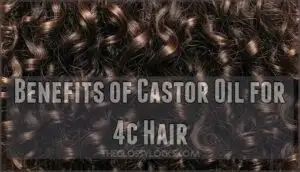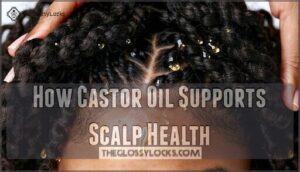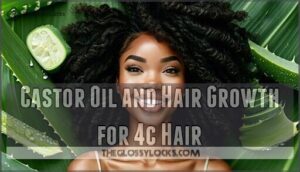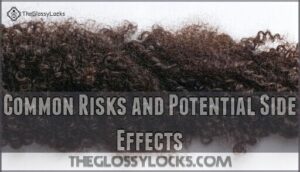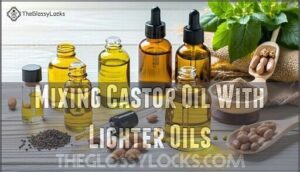This site is supported by our readers. We may earn a commission, at no cost to you, if you purchase through links.
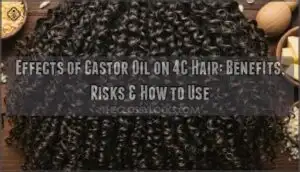
The effects of castor oil on 4c hair depend entirely on how you utilize its ricinoleic acid content, which accounts for nearly 90% of its fatty acid profile. When applied strategically, this thick botanical oil creates an occlusive barrier that seals hydration into your strands, fortifies follicles against mechanical stress, and improves scalp circulation during massage.
Understanding which type of castor oil matches your porosity level and how often to apply it transforms this ancient remedy from a greasy mistake into a targeted treatment that treats the specific vulnerabilities of tightly coiled hair.
Table Of Contents
- Key Takeaways
- What is Castor Oil and How Does It Work?
- Benefits of Castor Oil for 4c Hair
- How Castor Oil Supports Scalp Health
- Castor Oil and Hair Growth for 4c Hair
- Common Risks and Potential Side Effects
- Best Ways to Use Castor Oil on 4c Hair
- Frequently Asked Questions (FAQs)
- How long should castor oil be left in 4c hair?
- Do I need to wash out the castor oil after each use?
- Are there any other oils that can be used in combination with castor oil?
- Does castor oil work for all hair types?
- How long until visible growth results appear?
- Does castor oil work on low porosity hair?
- Can I use castor oil on colored hair?
- Should I apply castor oil to wet hair?
- Conclusion
Key Takeaways
- Castor oil’s effectiveness on 4c hair depends entirely on dilution and application frequency—use it no more than once weekly, mixed with lighter oils like jojoba or grapeseed at a 1:3 ratio, to avoid irreversible matting and buildup that blocks moisture penetration.
- The oil’s 90% ricinoleic acid content creates an occlusive seal that locks hydration into strands and improves scalp circulation during massage, but it won’t directly stimulate hair growth—its real value lies in strengthening follicles and reducing breakage from mechanical stress.
- About 14% of users experience allergic reactions including redness, swelling, and delayed eczematous dermatitis, making patch testing essential before regular use, especially for those with oily scalps or existing seborrheic dermatitis.
- Apply castor oil only to 70% damp hair (never bone-dry or soaking wet) and always wash it out after 20-30 minutes to prevent product buildup, felting, and clogged follicles that undermine the moisture retention benefits you’re trying to achieve.
What is Castor Oil and How Does It Work?
Castor oil has been a go-to in natural haircare for decades, but not all castor oil is created equal. The type you choose and how it’s processed can make a real difference in how it works on your 4c strands.
Let’s break down what makes castor oil tick and why it matters for your hair.
Types of Castor Oil (Yellow Vs. Black Vs. Jamaican Black)
Not all castor oil is created equal—the type you choose can make or break your results with 4c hair. Yellow castor oil comes from cold-pressed raw beans, while black castor oil—especially Jamaican Black Castor Oil—undergoes a roasting process that changes its color and nutrient profile.
This traditional extraction method creates ash content and a darker hue, potentially offering enhanced benefits for hair care through different compound concentrations and absorption rates.
Key Nutrients and Compounds (Ricinoleic Acid, Vitamin E, Fatty Acids)
The roasting process matters less than what’s actually inside the bottle. Your hair nutrition depends on castor oil’s fatty acid profile, led by ricinoleic acid—which makes up 85–95% of the oil’s composition. That’s why penetration bioactivity runs so deep with this ingredient. Castor oil may also improve scalp health with its properties.
Here’s what powers castor oil’s reputation:
- Ricinoleic acid (90% of fatty acids)—delivers antimicrobial and anti-inflammatory benefits while enabling nutrient penetration
- Vitamin E content (tocopherols at 43–97 mg/g)—offers antioxidant protection and aids oil stability
- Omega fatty acids (oleic 2–6%, linoleic 1–5%)—nourish strands and lock in moisture
- Polyphenols (632 µg GAE/g)—defend against oxidative stress that weakens 4c hair
How Castor Oil Interacts With 4c Hair Structure
Your 4c strands aren’t just sitting there waiting to soak up oil—they’re working with a tightly coiled structure that changes how castor oil moves, sits, and delivers those nutrients we just covered.
Porosity impact determines whether castor oil penetrates or coats the cuticle, affecting moisture retention and hair health. Its occlusive nature seals hydration into low-porosity 4c hair, reducing breakage patterns while improving elasticity effects and curl definition through targeted hair strengthening and moisturizing action.
Benefits of Castor Oil for 4c Hair
Castor oil has earned its reputation as a powerhouse ingredient for 4c hair, and the science backs it up. The oil’s unique composition directly tackles some of the most common challenges you face with tightly coiled strands.
Here’s what castor oil can actually do for your hair.
Deep Moisturization and Hydration
One of the most critical benefits of castor oil for 4c hair lies in its ability to lock moisture into every strand, thanks to its thick, occlusive nature that acts like a protective seal over your hair shaft. This oil boosts water retention by forming a barrier that prevents hydration loss, which is especially important for low porosity levels. For best results, pair castor oil with a humectant to help hydrate and moisturize deeply, extending your hydration duration between wash days.
- Occlusive properties: Castor oil’s thick consistency creates a protective film that traps moisture inside your hair cuticles, preventing environmental dryness.
- Enhanced water retention: Its ricinoleic acid content helps your strands hold onto water longer, addressing 4c hair’s natural tendency toward dryness.
- Humectant pairing strategy: Combine castor oil with glycerin or aloe vera to draw moisture in first, then seal it effectively for maximum hair moisturizing benefits.
Strengthening and Reducing Breakage
Beyond holding onto hydration, castor oil works at a deeper structural level—fortifying each strand from within to shield against the mechanical stress that 4c hair faces daily. Its vitamin E and fatty acids boost protein retention, which directly improves elasticity and prevents split ends.
This means your hair can stretch during detangling or protective styling without snapping. By maintaining hydration balance, castor oil aids hair strengthening and conditions strands to resist breakage naturally.
Enhancing Shine and Softness
The lustrous finish castor oil delivers isn’t just about surface coating—it’s a side effect of genuine strand repair that transforms dull, roughened cuticles into smooth, light-reflective surfaces. As a hair moisturizer and conditioning agent, castor oil’s ricinoleic acid smooths raised cuticle layers, which directly improves shine longevity and softness retention.
- Oil combinations with lighter carriers (jojoba, grapeseed) refine absorption without heaviness
- Application techniques matter—distribute from mid-shaft to ends for best hair shine
- Heat application through warm towel wraps improves penetration and hair softness
- Consistent use builds cumulative hair conditioning effects over weeks
- Results depend on strand porosity and existing cuticle damage levels
Thickening and Volumizing Effects
When ricinoleic acid saturates hair fibers over several weeks, individual strand thickness can improve measurably—studies note up to 70% of users report perceivable hair thickening within three months of consistent castor oil application. This volumizing effect stems from moisture retention that temporarily plumps cuticles, creating density perception particularly notable in 4c textures.
Result persistence depends on ongoing use; discontinuation reverses fullness within four to six weeks. Compared to lighter oils like jojoba, castor oil delivers enhanced hair growth and health outcomes for coily types, though over-application risks buildup that counteracts initial gains.
It’s also known to stimulate blood circulation on the scalp.
How Castor Oil Supports Scalp Health
Your scalp’s health determines whether your 4c hair thrives or struggles. Castor oil doesn’t just sit on the surface—it works beneath it, addressing circulation, microbial balance, and inflammatory responses that affect growth.
Let’s break down how it aids the foundation of healthy hair.
Promoting Blood Circulation
When you massage castor oil into your scalp, you’re doing more than coating the surface—you’re encouraging fresh blood flow to reach every follicle, delivering oxygen and nutrients that support healthier, more resilient hair growth.
This scalp massage triggers follicle stimulation by dilating blood vessels, which improves nutrient delivery directly to the hair root. Improved oxygen supply strengthens the follicle itself, creating a stronger foundation for each strand.
Antibacterial and Antifungal Properties
Castor oil acts like a protective barrier for your scalp, thanks to its natural antimicrobial power. Ricinoleic acid—the dominant fatty acid in castor oil—disrupts harmful microbes that thrive in moist, warm environments, helping maintain a balanced scalp microbiome and reducing the risk of infection.
- Fungal control: Targets common scalp fungi that contribute to flaking and irritation
- Infection prevention: Antioxidant properties support scalp health by reducing inflammation and oxidative stress
- Dandruff relief: Combats microbial overgrowth linked to persistent dandruff and scalp inflammation
Soothing Dry, Itchy, or Irritated Scalp
If you’ve ever dealt with that nagging itch that won’t quit or the tightness of a parched scalp, you know how distracting and uncomfortable it can be.
Castor oil’s occlusive nature locks in scalp hydration, while ricinoleic acid delivers inflammation reduction at the follicle level.
The gentle application of this natural remedy provides soothing properties that ease irritation without stripping your scalp’s protective barrier, making it a cornerstone of effective scalp care for 4c hair moisturizing routines.
Treating Dandruff and Scalp Conditions
Dandruff and other scalp conditions don’t just show up on their own—they’re often your scalp’s way of signaling that something’s off balance, whether it’s fungal overgrowth, inflammation, or barrier disruption. Castor oil’s antibacterial and antifungal properties tackle the root causes of dandruff, while its ricinoleic acid content reduces scalp inflammation and helps regulate sebum control. When used strategically as a scalp treatment, it treats fungal infections without aggravating product allergies.
- Dandruff reduction through targeted antimicrobial action
- Scalp inflammation management via ricinoleic acid’s soothing effect
- Sebum control that rebalances oil production without over-drying
Castor Oil and Hair Growth for 4c Hair
You might’ve heard claims that castor oil speeds up hair growth, but let’s separate myth from fact. The truth is nuanced—castor oil doesn’t magically make your strands sprout overnight, but it does create conditions that support healthier growth over time.
Here’s what actually happens when you apply castor oil to your 4c hair and scalp.
Stimulating Follicles for Growth
Beyond the hype around Hair Growth lies a more nuanced reality. Ricinoleic acid, which constitutes 85–90% of castor oil, may inhibit prostaglandin D2 synthase—a compound linked to follicle miniaturization. However, no randomized controlled trials confirm direct Hair Follicle Stimulation in human scalps. Most evidence for Hair Regrowth remains anecdotal. What castor oil does offer is Follicle protection through improved Scalp Health and Hair Growth conditions: Scalp microcirculation increases during massage, Moisture retention limits water loss, and antioxidants shield follicles from oxidative stress. These Evidential gaps matter.
Castor oil’s hair growth claims lack clinical proof—it protects follicles through scalp health and moisture retention, not direct growth stimulation
| Mechanism | Supporting Evidence |
|---|---|
| Ricinoleic acid effects | In vitro models; no human trials |
| Scalp microcirculation | Small studies on massage; not isolated to castor oil |
| Moisture retention | Occlusive properties confirmed; indirect follicle benefit |
| Antioxidant protection | Laboratory data; clinical correlation unclear |
| Direct follicle stimulation | Anecdotal only; no peer-reviewed proof |
Minimizing Hair Loss and Shedding
Shedding 50–100 hairs daily is normal physiology—but when your pillowcase or detangling session looks like evidence of something worse, it’s time to understand what castor oil can and can’t do.
Castor oil won’t reverse Hair Loss driven by genetics or hormones. It does address Breakage Prevention through improved Hair Elasticity and Follicle Health.
Ricinoleic acid strengthens strands, reducing Hair Breakage during manipulation or Protective Styles—a real win for Hair Strengthening where fragility meets tension.
Improving Hair Density Over Time
Density—that coveted fullness you see when your twists actually look thick—isn’t built overnight, but consistent castor oil use can shift the trajectory of your strand count per square inch.
Here’s what governs real Hair Growth and Thickening:
- Scalp Stimulation improves circulation, creating better conditions for Natural Hair Growth
- Consistent Application over months—not weeks—shows measurable Hair Regrowth and Thickening
- Genetic Predisposition sets your ceiling; castor oil optimizes what’s possible within that range
Pair castor oil with a Healthy Diet. Patience Required—density builds slowly, but it builds.
Common Risks and Potential Side Effects
Castor oil isn’t a one-size-fits-all solution, and it’s important to know where things can go wrong. While many people see great results, others experience unwanted effects that can actually set back their hair goals.
Let’s walk through the main concerns you should keep in mind before making castor oil a regular part of your routine.
Product Buildup and Hair Felting
The thick, occlusive nature of castor oil can work against you if you’re not careful—turning what should nourish your 4c hair into a stubborn layer of buildup or, in extreme cases, an irreversible matting condition called acute hair felting.
Oil overuse leads to castor oil buildup that prevents moisture penetration and causes hair damage. Buildup symptoms include dullness, stiffness, and tangling. Hair felting requires cutting affected sections.
Preventative measures include proper dilution and regular hair detox treatments with clarifying shampoos.
Scalp Sensitivity and Allergic Reactions
While castor oil offers many benefits, your scalp might not always welcome it—especially if you’re among those prone to allergic reactions or sensitivity. Research shows that about 14% of people tested positive for castor oil allergy, making it the fourth most common contact allergen in certain groups.
Watch for these allergy symptoms:
- Redness and swelling localized where you applied the oil
- Itching or eczematous dermatitis that worsens with continued use
- Facial edema or perioral eczema if castor oil migrates from scalp to face
- Delayed reactions appearing 2-4 days after application
- Symptoms resolving within days of stopping use
Risk factors include younger age, female gender, underlying atopic conditions, and occupational dermatoses. Patch testing before regular use helps identify sensitivity—apply a small amount behind your ear for 48 hours. If you experience persistent irritation, consult a dermatologist.
Hydrogenated and PEG oil derivatives cause fewer reactions than pure castor oil, so use precautions with undiluted formulations. Your scalp health depends on recognizing when this popular treatment isn’t right for you.
When to Avoid Castor Oil (Oily Scalp, Dermatitis)
If your scalp already overproduces sebum or you’re managing seborrheic dermatitis, adding castor oil to your routine might backfire in ways you didn’t expect. The occlusive nature of castor oil traps existing sebum, worsening oily scalp conditions and potentially triggering scalp inflammation.
If you have low hair porosity, the oil sits on strands rather than penetrating. Product allergies compound these issues.
Medical consultation with a dermatologist helps determine whether castor oil suits your scalp health needs—especially when existing conditions affect scalp health and care.
Best Ways to Use Castor Oil on 4c Hair
Using castor oil on 4c hair isn’t just about slathering it on and hoping for the best. You need a strategy that maximizes benefits while avoiding the pitfalls we’ve discussed.
Here’s how to incorporate castor oil into your haircare routine effectively.
Frequency and Amount for Optimal Results
For 4c hair, less is almost always more—aim to use castor oil no more than once per week to avoid turning your hair care routine into a cleanup project. Application frequency hinges on individual needs and scalp tolerance, but weekly treatments strike the right balance for hair moisturization and hair growth without triggering buildup.
Start with a quarter-sized amount for your entire scalp—seriously, that’s enough—and adjust based on your hair’s response to maintain ideal scalp health.
Mixing Castor Oil With Lighter Oils
You wouldn’t drive a semi-truck down a narrow alley, so why coat your 4c strands with pure castor oil when blending it with lighter oils makes all the difference? Proper oil ratios improve absorption rates and scalp compatibility while delivering effective hair moisturizing and hair growth benefits.
Best combinations for natural hair treatment:
- 1:3 ratio – one part castor oil to three parts jojoba or sweet almond oil for daily application techniques
- Coconut oil blend – boosts penetration without sacrificing moisture retention
- Grapeseed oil mix – lightweight carrier that won’t weigh down fine strands
- Argan oil combination – balances thickness while promoting shine and manageability
- Avocado oil pairing – nutrient-rich option for intensive hair treatment sessions
These blends maximize castor oil’s benefits without the heavy buildup.
Hot Oil Treatments and Scalp Massages
Think of heat as the key that unlocks castor oil’s full potential—hot oil treatments combined with scalp massages transform a sluggish product into a penetrating powerhouse. Warm your castor oil blend to a comfortable treatment temperature (not scalding), then apply using circular massage techniques to boost scalp stimulation and blood flow.
This hair treatment approach improves nutrient delivery to follicles, supporting hair growth while improving scalp health through increased absorption and deeper moisture penetration during your 20-30 minute application duration.
Tips to Prevent Buildup and Damage
While hot oil treatments work wonders, misuse turns castor oil from hair hero to sticky nightmare—proper application techniques and maintenance routines keep your 4c strands thriving without the dreaded buildup.
- Dilution methods: Mix castor oil with lightweight alternatives like grapeseed or jojoba to reduce viscosity and prevent product buildup
- Application frequency: Limit treatments to once weekly to avoid overwhelming your hair with natural hair products
- Clarifying shampoos: Use monthly to remove residue and support hair detox and treatment protocols
- Scalp exfoliation: Gently massage your scalp before washing to lift accumulated product buildup and hair damage
- Targeted application: Focus on mid-lengths and ends rather than saturating your entire scalp with heavy formulations
Frequently Asked Questions (FAQs)
How long should castor oil be left in 4c hair?
Generally, castor oil should stay in 4c hair for 20–30 minutes as a treatment, preventing buildup risk while allowing product absorption. Hair porosity matters—low porosity may need heat.
Incorporating it into your wash routine and hair care routine aids hair moisturizing without compromising natural hair care practices.
Do I need to wash out the castor oil after each use?
Like rinsing oil from a pan, washing out castor oil after each use prevents buildup and maintains scalp health.
Product residue accumulates when left unwashed, leading to clogged follicles and hindering hair moisturizing benefits in natural hair care routines.
Are there any other oils that can be used in combination with castor oil?
Mixing castor oil with lighter carrier oil blends—like jojoba, argan, or sweet almond—improves spreadability and absorption.
Essential oil pairings such as rosemary or peppermint boost scalp circulation.
These DIY hair masks work well as pre-shampoo treatments.
Does castor oil work for all hair types?
Most hair types benefit from castor oil’s moisturizing properties, but individual sensitivities, porosity considerations, and scalp conditions determine compatibility.
Natural hair often responds well, though product buildup risk varies with hair type variations and existing scalp health.
How long until visible growth results appear?
Most people notice baby hairs around the hairline within six to eight weeks of Consistent Application, but Individual Variation means your Growth Timeline may differ. Realistic Expectations matter—hair naturally grows slowly, and Measuring Growth requires patience.
Castor Oil aids Hair Growth and Health by nourishing follicles and reducing Hair Loss, but it’s not a miracle cure for Hair Loss and Treatment concerns.
Does castor oil work on low porosity hair?
Castor oil can work on low porosity hair, but heat application is often necessary. Low porosity hair resists oil absorption due to tightly closed cuticles. Warming the oil improves penetration, enhancing hair moisture retention and reducing product layering challenges.
Can I use castor oil on colored hair?
Yes, castor oil works well with color-treated strands. Its occlusive properties seal moisture without causing significant color fading or dye compatibility issues.
However, porosity changes from chemical processing may affect absorption rates, potentially increasing strand damage risk if overused.
Should I apply castor oil to wet hair?
Damp strands absorb castor oil more effectively than completely dry hair. The moisture helps distribute this thick oil evenly, preventing concentration in single areas.
Pat your hair until it’s about 70% dry, then apply castor oil for best absorption and easier styling.
Conclusion
Here’s the catch: the effects of castor oil on 4c hair only work in your favor when you respect its viscosity and treat it like a concentrated serum, not a leave-in conditioner.
Dilute it with lighter carriers, apply it sparingly to damp strands, and never exceed twice-weekly use unless you’re treating a specific scalp condition.
Your coils don’t need more product—they need smarter application that locks in moisture without suffocating your follicles or creating felting at your roots.
- https://www.carolsdaughter.com/blog/hair/hair-care-tips/castor-oil-for-hair-growth.html
- https://pubmed.ncbi.nlm.nih.gov/35816075/
- https://africanpridehair.com/texture-guide/blog/how-to-use-black-castor-oil-for-hair-growth-and-get-results/
- https://www.elle.com/beauty/hair/g68132792/best-essential-oils-for-hair-growth-explained/
- https://pmc.ncbi.nlm.nih.gov/articles/PMC5596646/

